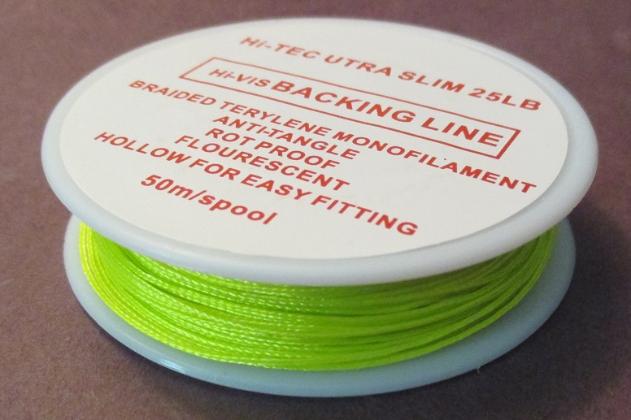Fly Line Backing:
Most fly lines are only 80 to a 100 feet long. Fly line backing increases that length to allow for long runs from hard fighting fish. It also serves as a variable that helps keep the spool of the fly reel near full rather than using only a small part of the overall diameter of the spool. It’s a thin but very strong section of line that’s secured directly to the arbor of a fly reel and to the back end of a fly line. In essence, its added insurance that a big fish don’t empty your fly reel and break off. Most trout fishing reels requires about 50 yards of 20-pound backing.
The Hi-Tec ultra slim line is made of braided Terylene Monofilament. It is anti-tangle, rot-proof, flourescent and hollow for easy fitting.
Installing the backing on your fly reel spool.
You should attach the backing directly to the fly reel spool arbor. Several knots will work, even a couple of overhand knots. You can manually wind the backing on the spool, use a motorized rigging tool, or use a manual line winder. The tools just shorten the time it takes to wind it on the spool. Wind the appropriate amount of backing onto the reel. You want to make certain it is wound on tight and evenly under some pressure so that a hard fighting fish doesn’t cause the backing to cut down into itself, or loosely wound backing.
Do not pull the backing off the side of its factory spool. This will introduce twist into the backing. Never put too much backing on the spool. You usually won’t need it unless you are fishing for hard fighting, long running fish like some of the saltwater species or steelhead.
Getting the right amount of backing on the spool can be critical. On small arbor reels with a small diameter you may need more backing to fill up the spool. If you put too much backing on, it will end up making the fly line come in contact with the outside bars of the reel. You won’t know this until you finish putting the fly line on and in that case, you will need to start over.
You attach the back end of your fly line to the tag end of the backing. This is best done using a spliced, double-nail-knotted braided loop and a Bimini twist. This type of connection lets you quickly and easily switch fly lines without having to retie any knots. There are other options.
